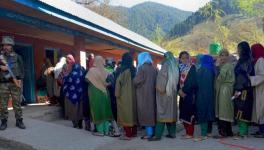New J&K Land Laws: Turning the Clock Back for Peasantry
Discussing the negotiations on the Delhi Agreement in the Lok Sabha on July 24, 1952, the then Prime Minister Jawaharlal Nehru said:
“…our friends from Kashmir were very apprehensive about one or two matters. For a long time, past, in the maharaja’s time, there had been laws there preventing any outsider, that is, any person from outside Kashmir, from acquiring or holding land in Kashmir.
“If I mention it, in the old days the maharaja was very much afraid of a large number of Englishmen coming and settling down there, because the climate is delectable, and acquiring property. So, although most of their rights were taken away from the maharaja under the British rule, the maharaja stuck to this that nobody from outside should acquire land there. And that continues.
“So, the present government of Kashmir is very anxious to preserve that right because they are afraid, and I think rightly afraid, that Kashmir would be overrun by people whose sole qualification might be the possession of too much money and nothing else, who might buy up, and get the delectable places. Now they want to vary the old maharaja’s laws to liberalise it, but nevertheless to have checks on the acquisition of lands by persons from outside…
“So, we agreed and noted this down: ‘The state legislature shall have power to define and regulate the rights and privileges of the permanent residents of the state, more especially in regard to the acquisition of immovable property, appointments to services and like matters. Till then the existing state law should apply.’”
(A. G. Noorani, Article 370: A Constitutional History of Jammu and Kashmir, 2011)
Under the Delhi Agreement, the State Legislature of Jammu & Kashmir (J&K) was given the power to make laws for conferring special rights and privileges on the ‘State subjects’ in view of the ‘State Subject Notifications of 1927 and 1932’. As a result, Article 35A was added to the Indian Constitution through the Presidential Order of 1954.
Article 35A conferred the power on the state legislature to enact laws defining classes that will constitute permanent residents of the state and will be conferred with special rights and privileges with respect to employment and ownership of immovable property. It was based on Maharaja’s Notification of April 20, 1927, issued as a result of demands by Kashmiri Pandits, who feared loss of employment and security in the wake of influx of people to the state from Punjab.
Prominent lawyer and historian of the constitutional history of J&K, A G Noorani argues: “Article 35A was based on a solemn pact between the Union and the State. It cannot be unilaterally altered.”
Nonetheless, on August 5, 2019, in a sudden and unilateral move, the Indian government de-operationalised Article 370 of the Indian Constitution. This, in turn led to a revocation of Article 35A. The special rights ensured to the erstwhile permanent residents of the state through this provision had also been annulled.
On August 9, 2019, the J&K Reorganisation Act was passed through which state laws prohibiting transfer of land to non-permanent residents were amended to permit such transfer. These amendments include – Section 4 of J&K Alienation of Land Act, 1938, Section 20-A of Big Landed Estates Abolition Act, 1950, Section 4 of J&K Land Grants Act, 1960 and Section 17 of J&K Agrarian Reforms Act, 1976. All of these provisions have been repealed by the 2019 Act.
Now, the government of India has vast land resources of J&K in its control, which are also available for Indian corporate players to buy, along with the land of the peasantry.
Following the developments in August 2019, legislative and administrative changes have been made at lightning speed. In the shadow of the COVID-19 lockdown and curbs, a new domicile law has been enforced and demographic change initiated. A new Land Act is underway.
The New Kashmir Policies of 2020 are in process of being introduced, a number of them concerning land and its utilisation. In addition to the grave violations of democratic rights of the people of J&K, at stake are the hard fought land rights of the peasantry of the erstwhile state.
Hard-fought land rights of the peasantry
In his statement to the Constituent Assembly of J&K on August 11, 1952, Sheikh Abdullah, who was appointed the state’s Prime Minister, said:
“There are historic reasons which necessitate such constitutional safeguards as for centuries past, the people of the State have been victims of exploitation at the hands of their well-to-do neighbours.
“The Hon’ble Members are perhaps aware that in the late twenties, the people of Jammu and Kashmir agitated for the protection of their bona fide rights against the superior competing interests of the non-residents of the State. It was in response to this popular demand that the Government of India appreciated the need for such a safeguard.
“No definition of the special rights and privileges of the residents of the State can afford to remain static. The need may arise at one stage or the other to liberalise such a definition. The importance of the fact that State Legislature shall retain powers to be able to effect such modifications becomes obvious in this context.”
(A. G. Noorani, Article 370: A Constitutional History of Jammu and Kashmir, 2011)
One of the top priorities of the new government of J&K was to make the landless peasantry of the state (about 86% of the state population at that time) land sovereign through land redistribution. Consequently, ‘land to the tiller’ reforms were enacted and implemented by the government through the Big Landed Estates Abolition Act, 1950.
It was to protect this legislation, future reforms, and land rights ensured to the peasant classes that the leadership demanded - 1) sovereignty to legislate on the matters of the state, 2) special rights and privileges for permanent residents of the state, and 3) restrictions on acquisition of immovable property by people from outside the state of J&K.
By 1953, a total of 93,500 acres were vested in the state and 192,652 acres of land had been transferred to 160,939 tillers, granting each peasant an average of 1.23 acres. By the end of the decade, a total of 9,000 landowners were expropriated of their surplus land, which amounted to about 4,50,000 acres. Out of this surplus land, the tillers were granted ownership rights to around 2,30,000 acres. (Source: Government of J&K, Land Reforms in Jammu and Kashmir, 3-4)
Sovereignty over legislative matters was essential to protect these reforms from a wide range of political and legal challenges, including the challenges from Fundamental Rights enshrined in Part III of India’s Constitution.
The Right to Property was at that time a fundamental right guaranteed and protected by the Indian Constitution. As a result, land reform and zamindari abolition laws of the states were taken to courts by landlords in many Indian states, including Bihar, Uttar Pradesh and Madhya Pradesh.
Talking about the Big Landed Estates Abolition Act, Nehru clarified in his statement in Lok Sabha:
“…the question was how far these Fundamental Rights might come in the way of their legislation now or any later development of it. Certainly, we did not want them to come in the way of their legislation. We like their land legislation. We thought it was very good.”
(A. G. Noorani, Article 370: A Constitutional History of Jammu and Kashmir, 2011)
Land laws in erstwhile state of J&K
The legislations on land in the state were drafted and amended to strictly regulate alienation and utilisation of land – Jammu and Kashmir Alienation of Land Act, 1938 and Big Landed Estates Abolition Act, 1950. Not only was the transfer of land to non-permanent residents prohibited, any form of alienation of land by agricultural classes was strictly regulated.
Restrictions were put in place against transfer of agricultural land for non-agricultural purposes or to non-agricultural classes. Further, agricultural land could not be converted for non-agricultural use. These restrictions were actually meant to make sure that redistributed land was retained by tillers, who had finally become land-owners, and they were not arm-twisted into selling off their land by former landlords or any other interested parties.
The Big Landed Estates Abolition Act has been called the ‘Magna Carta’ of peasants in J&K. It was through this Act that the revolutionary reforms were enforced. Land in excess of the ceiling – 22.75 acre – was transferred to tillers of land free of any price or compensation. No compensation was granted to the former proprietors of appropriated land. The land redistributed was to be free from arrears and liabilities.
The land left untenanted was to be nationalised and redistributed to landless labourers and farm labourers (hired-labourers that were excluded from the definition of ‘tiller’). Further, government and state wastelands were released for cultivation and allocated to landless peasants, farm labourers and peasants whose landholdings were inadequate.
Due to the mountainous terrain, land available for cultivation was less in proportion to the number of cultivators. Therefore, restrictions were imposed on alienation of redistributed land without permission of the government to prevent fragmentation of landholdings.
Transfer of land in contravention of the Act was prohibited. The framers of the Act placed special emphasis on personal cultivation of land to ensure that land does not remain in the hands of ‘intermediaries’. Tenancy was strictly regulated and sub-tenancy was prohibited.
Clarifying the object of such strictures, the chief architect of the Act and Revenue Minister, Mirza Afzal Beg, said:
“We do not want a back-door entrance for the non-cultivating element into the agricultural system once again. We do not want to create intermediary interests in land for the sake of private profit.”
Mirza Afzal Beg, On the Way to Golden Harvests: Agricultural Reforms in Kashmir, 1951)
A number of distinguishing features make this Act stand out in comparison, even with the progressive land reform legislations of Kerala and West Bengal. The Act itself provided for a comprehensive legal procedure where abolition of ownership, identification of beneficiaries and actual distribution takes place as one integral whole. This made it most effective and exemplary. Further, under this Act, ‘tiller’ has been defined as “a person who tills land with his own hands or a tenant who self-cultivates the land under his proprietorship”.
An emphasis on ‘self-cultivation’ ensured that only the cultivating classes of tenants enjoyed the titles to redistributed land. This was in contrast to most reform legislations of Indian states that diluted the definition of tiller to include ‘supervision of servants or hired labour’.
Such legal manoeuvres effectively expanding the ambit of who can be classified as ‘tiller’ allowed for the non-tilling classes to become the new proprietors of the redistributed land across Indian states, at the cost of the tilling classes of hired agricultural labourers who continued to toil on the lands of the ‘good landlords’. (Source: Astha Saxena, Land Law in India, 2020)
Thereafter, the Jammu and Kashmir Agrarian Reforms Act, 1976 further clarified the definition of ‘personal cultivation’ to assert the need for the recognition of the person who physically tills the land instead of the one who merely claims legal ownership over it.
Through this Act, the ceiling on land was reduced to 12.5 acre. Section 4 of the Act vested the rights in land not held in personal cultivation in the state. Under Section 5, right to land held under personal cultivation above the ceiling limit was vested in the state.
Utilisation of land for purposes other than personal cultivation was prohibited and tenancy regulated. Strict restrictions were imposed on alienation of land and transfer of land to non-permanent residents was prohibited. The reasons for these restrictions were the same – to safeguard the peasantry’s land rights and prevent any kind of forcible alienation of their landholdings.
With the ongoing amendments and changes, these laws have already been amended to repeal constitutional and legal provisions prohibiting the transfer of land to non-permanent residents of the state. New policies and legislations will further ease the process of acquisition of lands currently vested in the peasantry.
Land Grab, Dispossession and De-Peasantisation
In September 2019, Home Minister Amit Shah told a delegation from J&K that “only government land would be used to establish industries, hospitals and educational institutions” and “nobody’s land would be taken away”.
In a statement in Indian Express, an official from the Ministry of Home Affairs clarified: “Putting too many restrictions on land acquisition will defeat the very purpose of abrogation of Article 370 and the objective of industrialisation and development in the region. Also, with outsiders being allowed to buy land, it will only push up prices and benefit the local people.”
These clarifications are far from reassuring in light of the fact that J&K had already been losing its agricultural land to rapid urbanisation and unplanned construction. A government order from 2016 noted, “..in the State of Jammu and Kashmir, the land is not only an important factor of production but also the basic means of subsistence for majority of the people. Unplanned constructions like raising of colonies, factories, brick kilns, shopping complexes and other commercial establishments, has severely affected the agricultural husbandry of the State”.
The order goes on to highlight, “..although, sufficient laws are in place which prohibit or restrict conversion of agricultural land for non-agricultural purposes, but, in the absence of housing policy, the State has witnessed unplanned growth of residential and commercial establishments.” Here, it is worth mentioning that the percentage of cultivable land to 'Reported area for land utilisation statistics' in 2015-16 was only 26%.
In July 2020, the J&K Administrative Council, under the chairmanship of Lieutenant Governor, GC Murmu, sanctioned the new J&K Housing, Affordable Housing, Slum Redevelopment and Rehabilitation and Township Policy, 2020. Besides the promise of construction of one lakh new dwelling units in the next five years, the policy has proposed incentives, such as exemptions from building permit fee, external development charges and ‘land use conversion’.
Another development that has been a point of contention is the amendment to the Control of Building Operations Act, 1988 and the J&K Development Act, 1970 by the Administrative Council to provide for special dispensation for carrying out construction activities in the areas notified as ‘strategic areas’ – in terms of requirements of the Armed Forces in such areas.
Protesting this amendment, the spokesperson of National Conference, Imran Nabi Dar, said: “The proposed amendment will add to the pool of land under the possession of the Army by cutting on the remaining arable and fertile land tracts available for agriculture activity. The strategic importance of Jammu and Kashmir is not confined to certain areas, as such the entire region is strategically important.”
Resonating these views, Peoples Democratic Party leader, Naeem Akhtar, called this development ‘scarier than the scrapping of the special status of J&K’ and added: “It seems we might not be left with enough land even for graveyards.”
The spokesperson of the J&K Administration (now a Union territory), however, clarified that the decision had nothing to do with transfer of any land to the Armed Forces and ‘strategic areas’ were to be notified from within the existing land of the Armed Forces.
Irrespective of these clarifications, the anxiety and alarm raised by Akhtar and Dar are neither unfounded nor surprising for anyone aware of military land grab in J&K. According to government records, the Indian military has grabbed 53,353 hectares in Kashmir under the guise of ‘national security’.
In early 2018, former J&K Chief Minister, Mehbooba Mufti informed the Legislative Assembly that 51,116 kanals of state land in Jammu and 3,79,817 kanals of land in Kashmir were under the unauthorised occupation of the Indian Armed Forces. This includes occupation of agricultural land, forest land, state land and private buildings, which has led to dispossession, de-peasantisation, and loss of livelihoods, further affecting food sovereignty of the peasantry in rural Kashmir.
The rapid liberalisation of land laws and policy changes being introduced after de-operationalisation of Article 370 and revocation of 35A will only further push the peasant classes of J&K back into precarity. For a state with a history of unprecedented reforms, it may be an unfortunate U-turn back to a deeply exploitative reality.
The writer is an author and a researcher with Tricontinental: Institute of Social Research. The views are personal.
Get the latest reports & analysis with people's perspective on Protests, movements & deep analytical videos, discussions of the current affairs in your Telegram app. Subscribe to NewsClick's Telegram channel & get Real-Time updates on stories, as they get published on our website.























